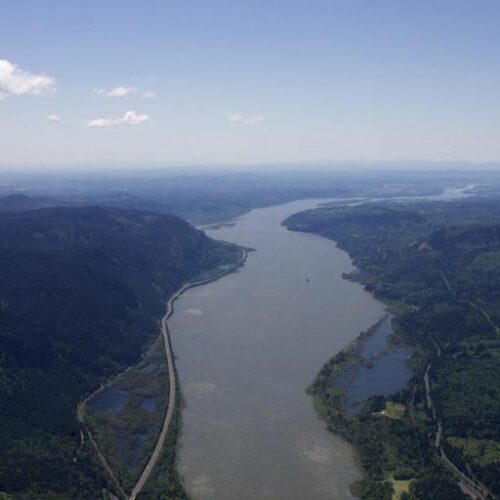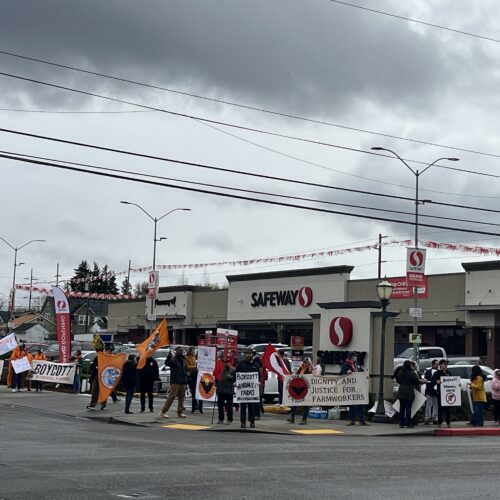
Columbia River Treaty Negotiators Ask For Patience Ahead Of Further Talks
Listen
The U.S. and Canadian governments have scheduled a second and third round of negotiations to modernize the Columbia River Treaty. The 54-year-old treaty provides flood protection to Portland and smoothes out Northwest hydropower production.
The two nations laid out their broad goals at the formal opening of treaty modernization talks in Washington, D.C., in late May. Now the talks will come to the Northwest—to Nelson, British Columbia in mid-August and a third round in Portland in September.
American chief negotiator Jill Smail of the U.S. State Department said the U.S wants to maximize “shared benefits” from transboundary coordination of water storage behind inland Northwest dams.
“Our objectives include continued, careful management of flood risk, ensuring a reliable and economical power supply, and better addressing ecosystem concerns,” Smail said.
Smail and her counterpart from Ottawa, Sylvain Fabi, asked an audience in Spokane Wednesday for patience and support.
“We expect the negotiations to take some time,” Fabi said. “These are complex issues with many interests at stake. Some of these interests also contradict each other. It doesn’t mean one is wrong and the other one is right. It’s just that at one point there’s a balancing.”
He said Canada’s overall negotiating goals echo the original 1964 treaty principles.
“As with the current treaty, our focus will be on flood risk management and power generation, but as you know we’re in a different world now,” Fabi said. “We will focus also our work on ecosystems and look for opportunities to improve the environment and strive to develop sufficient flexibility through the use of adaptive management.”
On one subtopic, Fabi said Canada is willing to cooperate on salmon restoration above Grand Coulee Dam.
The chief negotiators came from Ottawa and Washington, D.C. to Spokane to listen to a diverse panel of energy, navigation, local government and tribal interests convened under the auspices of the annual cross-border Pacific NorthWest Economic Region policy forum.
Speaking on behalf of Northwest U.S. electric utilities, a senior manager from Grant County Public Utility District urged the State Department to seek a better deal on electricity transfers from the U.S. Pacific Northwest to Canada. The Columbia River Treaty requires dam operators on the U.S. side of the border to deliver electricity to British Columbia as compensation for upriver water storage and coordination of river flows.
“The cost to electric ratepayers in Washington, Oregon, Idaho and Montana is about $150 million per year that we pay to Canada for downstream power benefits,” said Grant PUD’s Andrew Munro. “This payment is about 70-90 percent higher than the actual downstream power benefits the U.S. receives from the Canadian storage. We just would like to see a recalculated equal sharing based on modern means versus when the treaty was first put together.”
Fabi, the Canadian chief negotiator, glossed over what is known as the “Canadian Entitlement” in his forum remarks Wednesday, but Canada is expected to push back on this.
The chairman of the Yakama Nation tribal council, JoDe Goudy, spoke the most forcefully of the 30 pre-selected panelists. He delivered remarks in favor of stronger ecosystem restoration measures and tribal representation while dressed in full native regalia including an elaborate feather headdress.
“We are taking steps in the modern day present time for the extinction of salmon,” Goudy said of the region. “All of your constituents have reaped the benefit of being able to turn on their light switches and to be able to build structures in the floodplain. That has been at the great detriment and sacrifice of the native nations who have inhabited this land since time immemorial.”
In her remarks, Mayor Deb Kozak of Nelson, British Columbia, described a slightly different hurt she wanted addressed. She and several county commissioners from northwestern Montana said long-time residents of the interior have not forgotten the small towns, forests and road links that were flooded by the large dams built on the upper Columbia River and its tributaries during the 1960s under the terms of the treaty.
“These are industrial reservoirs. They are not lakes,” Kozak said.
She cited fluctuations in water levels which limit recreation and tourism possibilities as well as expose mudflats that dry out and create dust storms.
“These massive fluctuations cause negative impacts on communities,” Kozak said. “We’re saying enough is enough.”
“None of you have made our job easier, but that’s OK,” Fabi said at the conclusion of the morning-long session. “We were expecting that.”
Copyright 2018 Northwest News Network
Related Stories:

Canadian leaders hope trade negotiations won’t derail Columbia River Treaty
A view of the Columbia River in British Columbia. The Columbia River Treaty is on “pause” while the Trump administration considers its policy options. However, recent comments by President Donald

Feds update Columbia River Treaty flood risk management
Grand Coulee Dam in eastern Washington. Changes to the Columbia River Treaty could mean more flood risk management is controlled at the dam. (Credit: Shutterbug Fotos / Flickr Creative Commons)

Preliminary agreement reached for a modernized Columbia River Treaty
The Columbia River west of the Gorge as it heads toward Portland and out to the Pacific Ocean. (Credit: Amelia Templeton / OPB) WATCH Listen (Runtime 1:01) Read After more














